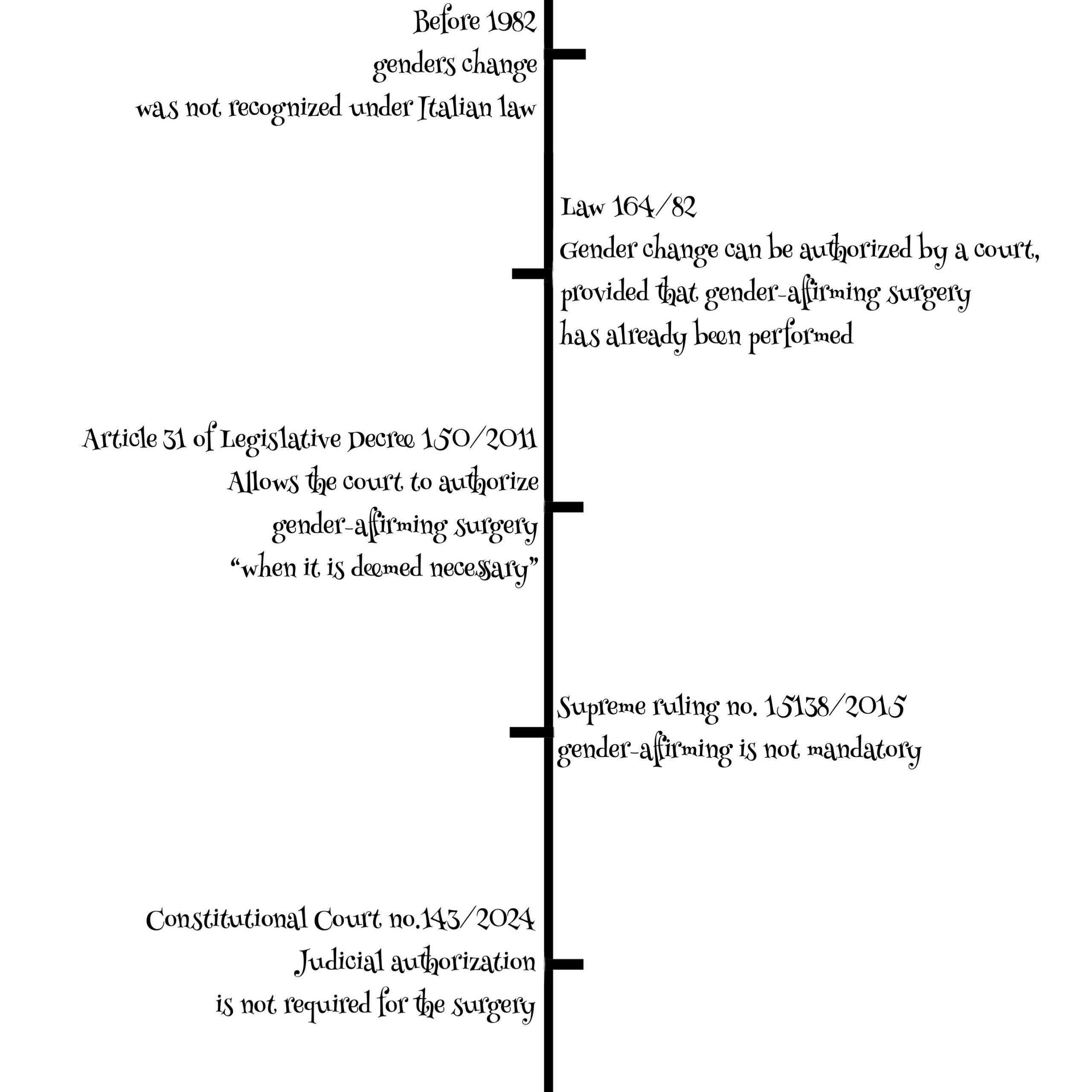Italy has always lagged behind. It was the last major Western democracy not to legally recognise gay partnerships until 2016 with the “Unioni Civili” (Law 20/05/2016 No. 76), and still today it does not adopt the principle of self-determination already present in many European countries. But is this backwardness limited only to legislation? What is it like to live as a queer person in Italy?
Chapter 1: “The History of Gender Change in Italy”

From Law 164/1982 (the first in Italy regarding gender change), the requirement to undergo surgery was clearly established.
There were two legal procedures:
- First, it was necessary to obtain authorisation from the court for gender reassignment surgery.
- After the operation, one could request authorisation to change the name and gender on official documents.
The later reform with Legislative Decree 150/2011 (Art. 31) did not clarify much regarding the mandatory nature of surgery, and Italian courts issued conflicting rulings until 2015.
Fortunately, since 2015 the situation has changed!
Judges have taken a more favourable stance towards trans people wishing to undergo gender transition. Gender-affirming surgery is no longer mandatory, only optional for MtF or FtM transitions.
Chapter 2: “Gender Transition in Italy”
Let’s start pragmatically: how can someone legally change their gender? The main steps are:
- Psychological evaluation
- Hormone therapy
- Legal process through the courts
Italy is still far from the simple registry correction made possible through self-determination, which in other countries can be done by going to the local registry office and changing your gender marker in a short amount of time.
1) Psychological evaluation
A report (or assessment) with a diagnosis of gender dysphoria is required.
In this first phase, a professional must write a report or perform an assessment to “verify” that the person suffers from gender dysphoria. This can be written by a professional (psychologist, psychotherapist or psychiatrist), either privately or through Italy’s public health system.
Unfortunately, feeling comfortable in your own skin is expensive: private care is faster (around 7 sessions total), but costs a lot (about 50 euros x 7 = 350 euros).
Moreover, reports from public services are often seen more favourably by Italian courts compared to those from private professionals.
However, public services are often overcrowded with very long waiting lists.
The Italian public health system is often criticised for its slowness, bureaucracy, lack of attention and disinterest from professionals.
With the public system, it takes a minimum of 6 months to complete only the psychological phase. Waiting times can reach 2 years or more just to obtain the psychological report!
2) Hormone therapy
This step is also required. Hormone therapy must be prescribed by an endocrinologist.
3) Legal process
Only an Italian court can authorise, through a ruling:
- the change of legal gender (MtF or FtM)
- the change of name
- possibly, the authorisation for surgery
The request can also be submitted by parents of Italian minors, as there have been cases in recent years of gender change procedures involving minors.
Court hearings
The first hearing generally takes place 2-3 months after the filing of the request, depending on the date set by the court. The judge will examine the documentation and facts stated in the request, and may appoint a court expert or schedule a final hearing.
Personal appearance, along with ongoing hormone therapy, may help “convince” the judge when they see a person with an appearance different from the gender marked in their documents.
Duration
It is not possible to predict the exact duration of the legal process, as each court has different timelines. However, an average duration of about 18 months can be expected without the support of a specialised lawyer, and about 6 months with a lawyer experienced in these cases. But nothing is guaranteed — many trans people have waited years before being legally recognised.
What does the court ruling establish?
- Name change, from male to female or female to male, as freely chosen by the individual
- Gender change, from M to F or F to M
Since 2024, court authorisation is no longer required to undergo surgery, as the gender rectification ruling is sufficient to allow surgical procedures.
Marriage
The gender rectification ruling dissolves the marriage or terminates its civil effects for previously married individuals. With the new identity, a person may marry again in Italy or abroad.
Civil Union
For those in a civil union, the Cirinnà Law states:
“The ruling for gender rectification automatically dissolves the civil union between same-sex partners” (Art. 1, paragraph 26, Law 20 May 2016, No. 76).
However, the Constitutional Court has ruled that:
“The person requesting the gender change and their partner may jointly ask the court to express the intention to marry. In this case, the judge can suspend the effects of the dissolution until the wedding is celebrated — as long as the new marriage takes place within 180 days from the final ruling of gender rectification”
Italy is still very far from a simple administrative rectification system, which would drastically reduce waiting times…
Sources
Legal matters:
Same sex unions:
Others:
Written by
Shape the conversation
Do you have anything to add to this story? Any ideas for interviews or angles we should explore? Let us know if you’d like to write a follow-up, a counterpoint, or share a similar story.
